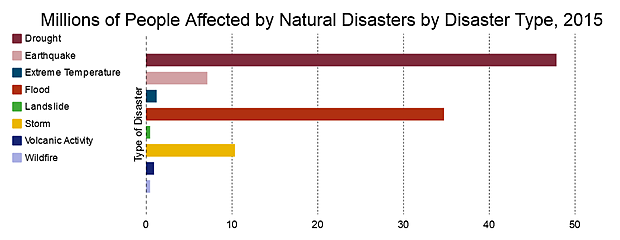Natural Disasters
|
Other types of disasters not included in this section
|
Natural disasters include earthquakes, extreme heat or cold, hurricanes, landslides and mudslides, lightning, tornadoes, tsunamis, volcanoes and wildfires.1 In 2015, the human death toll was 22,749 worldwide, with more than 102 million people affected by natural disasters. 2002 disasters impacted the greatest total numbers of humans since the start of the twentieth century: 658,053,168.2

Data from the Centre for Research on the Epidemiology of Disasters3

Data from the Centre for Research on the Epidemiology of Disasters4
Health Impacts of Natural Disasters
Human Influence on Natural DisastersEven though these disasters are caused by natural forces, human activity is having an impact, through emissions that contribute to climate change or by activities such as unconventional gas and oil extraction or clearing land of trees. Evidence is mounting that human activity is influencing the frequency and/or intensity of some types of disasters:5
|
Natural disasters can produce these health impacts, in addition to deaths:6
- Trauma and injury, whether directly from the disaster or secondarily, such as from traffic accidents, loss of access to needed medications such as insulin, loss of power needed for medical equipment or loss of access to medical care
- Increased incidence of communicable diseases including influenza and tuberculosis, plus diseases from contaminated or standing water, including those transmitted by insects. Examples include cholera, typhoid, scabies, trachoma, schistosomiasis, malaria, yellow fever and dengue.
- Increased incidence of heart attacks, asthma attacks and allergic responses
- Aggravation of pre-existing conditions due to stress, such as rheumatoid arthritis
- Malnutrition from lack of access to food through destroyed crops or food stores, or from lack of transportation infrastructure for food
- Food poisoning from the inability to store or cook food appropriately
- Heat- and cold-related injuries from lack of shelter or clothing
- Mental health disturbances
- Increased incidence of conditions related to air pollution, such as particulates produced by fires or added to the air by volcanoes, earthquakes, droughts and other disasters, or by carbon monoxide from inappropriate indoor combustion
- Increased incidence of conditions related to exposures to materials spilled or released during the disaster, including asbestos, fuels, industrial chemicals
- Increased impacts from exposure to mold
